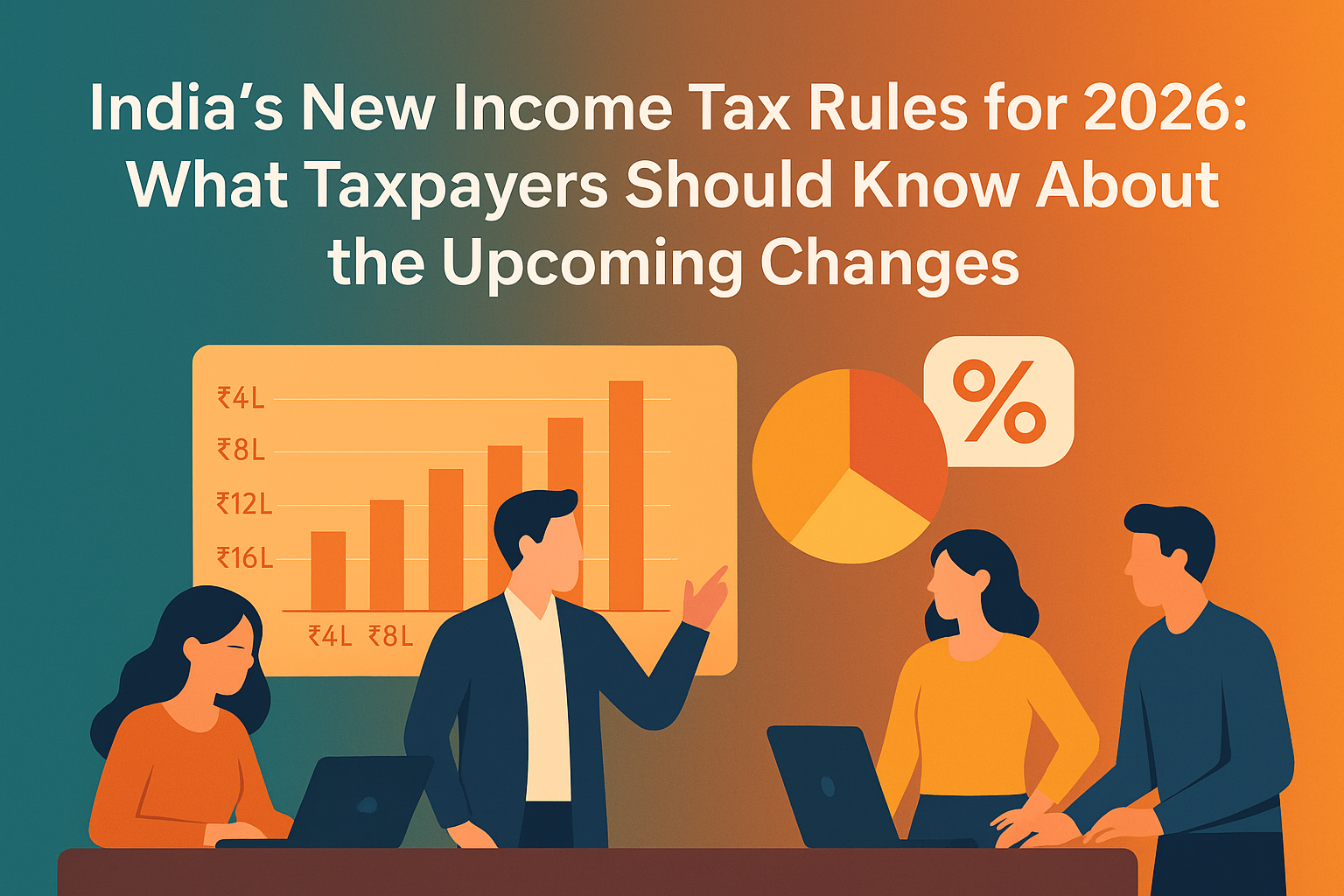Binarysoft is Authorised Tally Sales & Implementation Partner in India
+91 742 877 9101 or E-mail: tally@binarysoft.com 10:00 am – 6: 00 pm , Mon-Fri
Binarysoft is Authorised Tally Sales & Implementation Partner in India
+91 742 877 9101 or E-mail: tally@binarysoft.com 10:00 am – 6: 00 pm , Mon-Fri
Published on: 27-10-2025 Call CA Tally HelpDesk +91 9205471661, 8368262875

India’s taxation framework is about to go through one of its biggest reforms in decades. The government has proposed to replace the existing Income-tax Act of 1961 with a new and simplified Income-tax Act, 2025, which will come into effect from 1 April 2026. The goal is to make the tax system easier to understand, reduce disputes, and align India’s laws with a more digital and transparent economy.
For individuals, businesses, and professionals, these upcoming rules could significantly reshape the way taxes are calculated, filed, and reviewed. Here’s a detailed look at what’s changing and how it will impact taxpayers in 2026.
1. Introduction of a New Income-tax Law
The most important change is the introduction of a brand-new tax code. The government plans to replace the complex and outdated Income-tax Act 1961 with a modern law that uses simpler language and fewer sections.
The new Income-tax Act 2025 will reduce the number of sections from over 800 to around 530, while also reorganizing the structure to make it easier for ordinary taxpayers to read and understand. It will also include more illustrations, tables, and explanations for better clarity.
This reform is expected to reduce unnecessary litigation and make compliance easier for small and medium businesses as well as salaried individuals.
2. Revised Tax Slabs for Individuals
From the financial year 2025-26 (assessment year 2026-27), a revised tax-slab system under the new tax regime will apply. The new regime will continue as the default option for all individuals and Hindu Undivided Families (HUFs).
The proposed slabs are:
The rebate under Section 87A will also increase, ensuring that income up to roughly ₹12 lakh may effectively remain tax-free for most salaried taxpayers. This change is designed to give middle-class families more disposable income and encourage savings.
3. Simplified Definitions and Processes
The new law aims to simplify long-standing tax concepts. The terms “previous year” and “assessment year” are likely to be replaced by a simpler “tax year” concept. This will make understanding due dates and filing periods much easier for individuals.
Additionally, the process for calculating total income, claiming deductions, and setting off losses will be standardized across different types of taxpayers. The government also intends to make the return-filing process fully digital and faster, with better data matching between banks, employers, and the income-tax system.
4. Updated Rules for Capital Gains and Losses
One of the more interesting proposals involves capital gains. From the 2026 tax year onwards, taxpayers may get a one-time option to set off their long-term capital losses (LTCL) against short-term capital gains (STCG).
This flexibility will help investors who have accumulated losses in earlier years to reduce their tax burden when they sell other assets. It is a major step toward modernizing India’s investment-related taxation structure and aligning it with international standards.
5. Digital-First and Faceless Compliance
The new tax code will continue India’s move toward digital governance. Faceless assessments, electronic communication, and AI-assisted scrutiny are expected to become the norm.
Taxpayers will be able to submit supporting documents and clarifications online without visiting the tax office physically. Refunds are expected to be processed more quickly, and penalties for late filing will be handled in a more transparent way.
6. Impact on NRIs and Global Income
The 2025 Act will also redefine residency rules for Non-Resident Indians (NRIs) and Persons of Indian Origin (PIOs). The focus will be on actual stay and economic connection with India rather than just the number of days spent in the country.
This change will make taxation fairer and help India align with global residency principles. NRIs should carefully review their financial arrangements once the final rules are published.
7. Key Takeaways for Taxpayers
Conclusion
India’s new Income-tax Act 2025, effective from April 2026, marks a bold shift toward simplification, digital transparency, and taxpayer convenience. With clearer tax slabs, fewer sections, and a modern compliance system, the reform is expected to bring relief to individuals and businesses alike.
While the exact implementation details will emerge through official notifications, one thing is clear: taxation in India is entering a new, smarter, and more citizen-friendly era starting 2026.
Applicable for CAs / Firms Using GOLD (Multi User ) Only
Renew your license now and upgrade from Tally ERP 9 to Tally Prime for Free!₹ 6750 + 18% GST (₹ 1215)
Applicable for CAs / Firms Using GOLD (Multi User ) Only
Renew your license now and upgrade from Tally ERP 9 to Tally Prime for Free!
₹ 12150
+ 18% GST (₹ 2187)

Unlimited Multi-User Edition For Multiple PCs on LAN Environment
Renew your license now and upgrade from Tally ERP 9 to Tally Prime for Free!₹ 13500 + 18% GST (₹ 2430)
Unlimited Multi-User Edition For Multiple PCs on LAN Environment
Renew your license now and upgrade from Tally ERP 9 to Tally Prime for Free!
₹ 24300
+ 18% GST (₹ 4374)

Single User Edition For Standalone PCs ( Not applicable for Rental License )
Renew your license now and upgrade from Tally ERP 9 to Tally Prime for Free!₹ 4500 + 18% GST (₹ 810)
Single User Edition For Standalone PCs ( Not applicable for Rental License )
Renew your license now and upgrade from Tally ERP 9 to Tally Prime for Free!
₹ 8100
+ 18% GST (₹ 1458)

Tally On Cloud ( Per User Annual)
Now access Tally Prime anytime from anywhere – Just Deploy your Tally License and Tally Data on our Cloud Solution.₹ 7000 + 18% GST (₹ 1260)
Unlimited Multi-User Edition
For EMI options, please Call: +91 742 877 9101 or E-mail: tally@binarysoft.com (10:00 am – 6: 00 pm , Mon-Fri)₹ 67500 + 18% GST (₹ 12150)
Unlimited Multi-User Edition For Multiple PCs on LAN Environment
Renew your license now and upgrade from Tally ERP 9 to Tally Prime for Free!₹ 45000 + 18% GST (₹ 8100)
Single User Edition For Standalone PCs
For EMI options, please Call: +91 742 877 9101 or E-mail: tally@binarysoft.com (10:00 am – 6: 00 pm , Mon-Fri)₹ 22500 + 18% GST (₹ 4050)
(Per User/One Year)
TallyPrime latest release pre-installed₹ 7200 + 18% GST (₹ 1296)
(Two Users/One Year)
TallyPrime latest release pre-installed₹ 14400 + 18% GST (₹ 2592)
(Four Users/One Year)
TallyPrime latest release pre-installed₹ 21600 + 18% GST (₹ 3888)
(Eight Users/One Year )
TallyPrime latest release pre-installed₹ 43200 + 18% GST (₹ 7776)
(Twelve Users/One Year)
TallyPrime latest release pre-installed₹ 64800 + 18% GST (₹ 11664)
(Sixteen Users/One Year)
TallyPrime latest release pre-installed₹ 86400 + 18% GST (₹ 15552)
